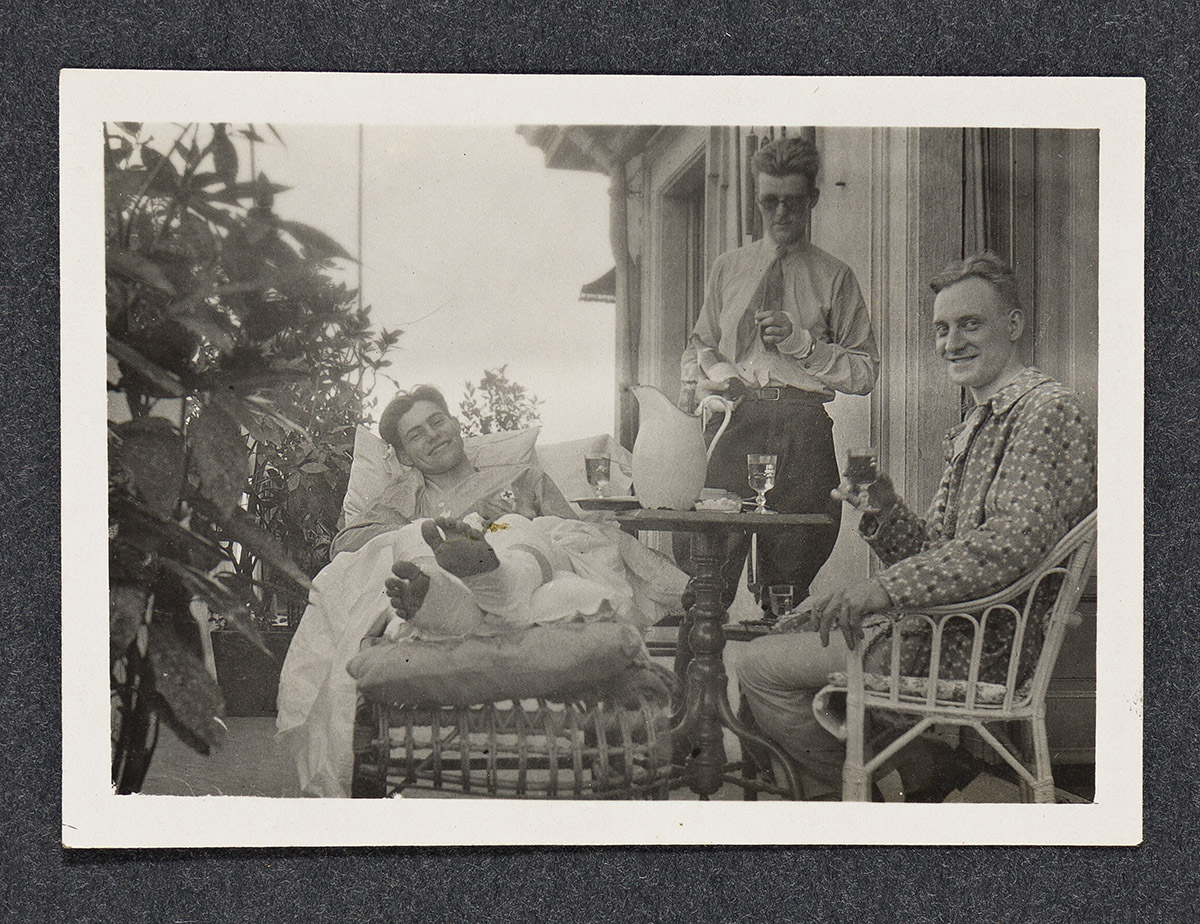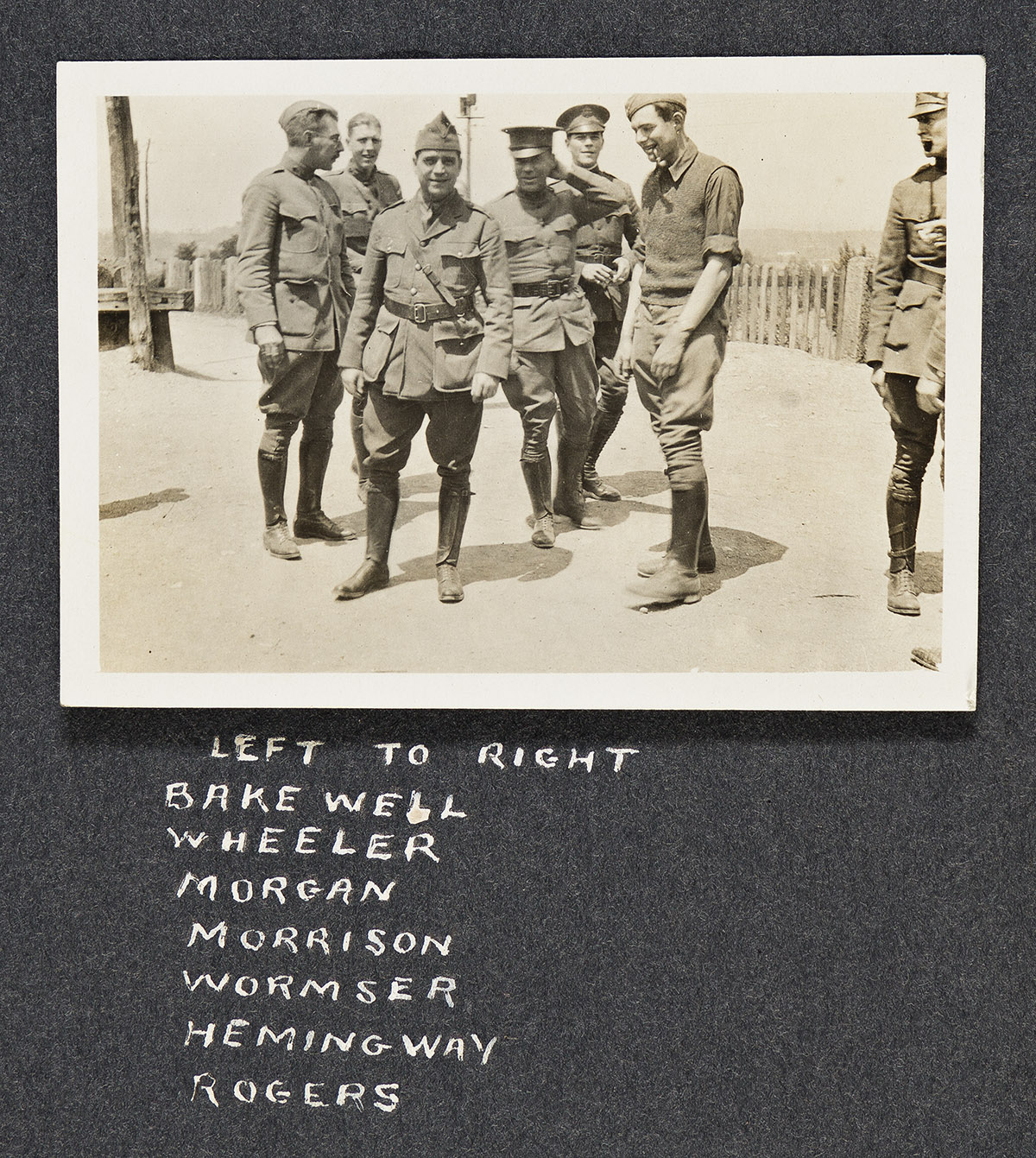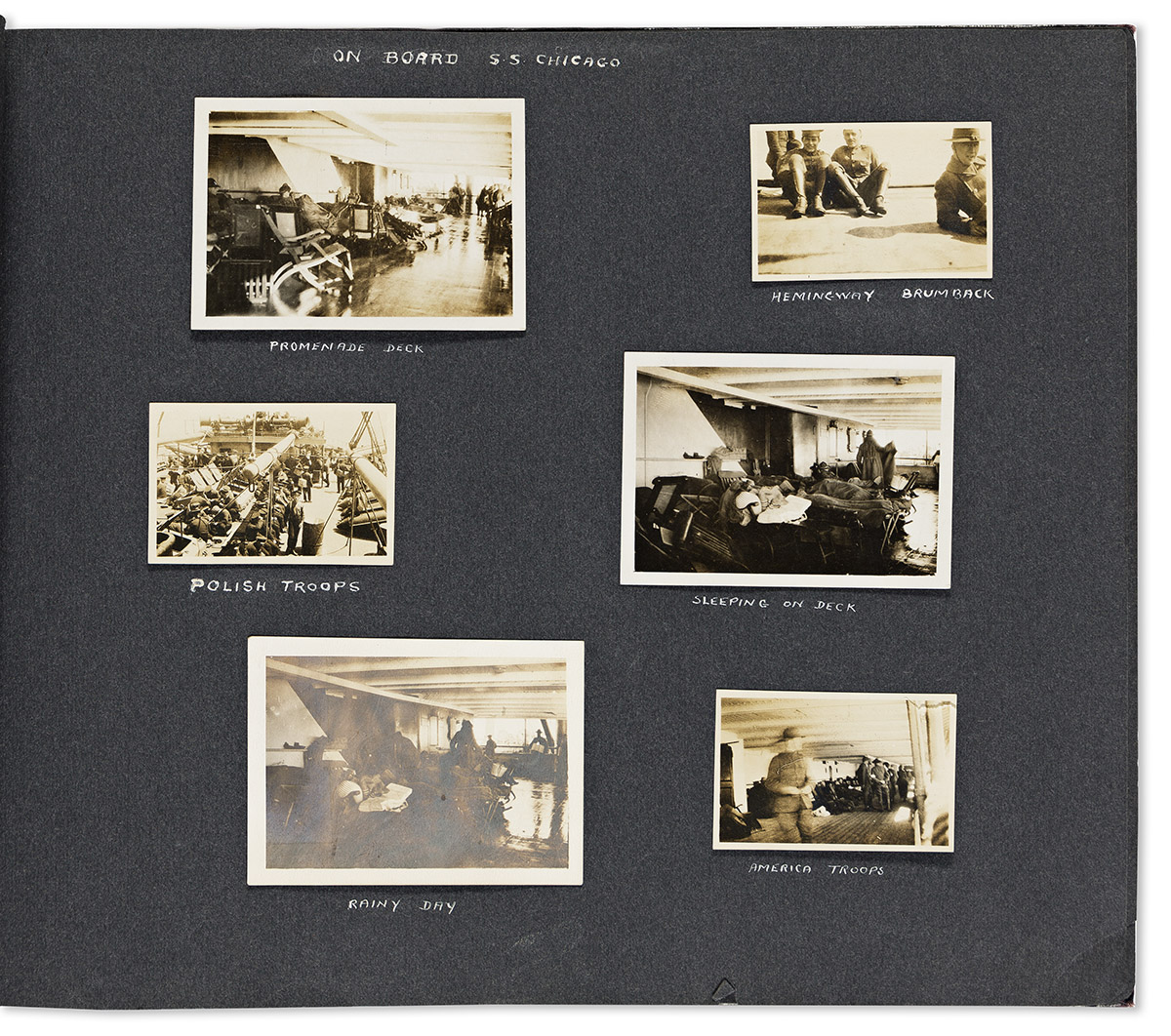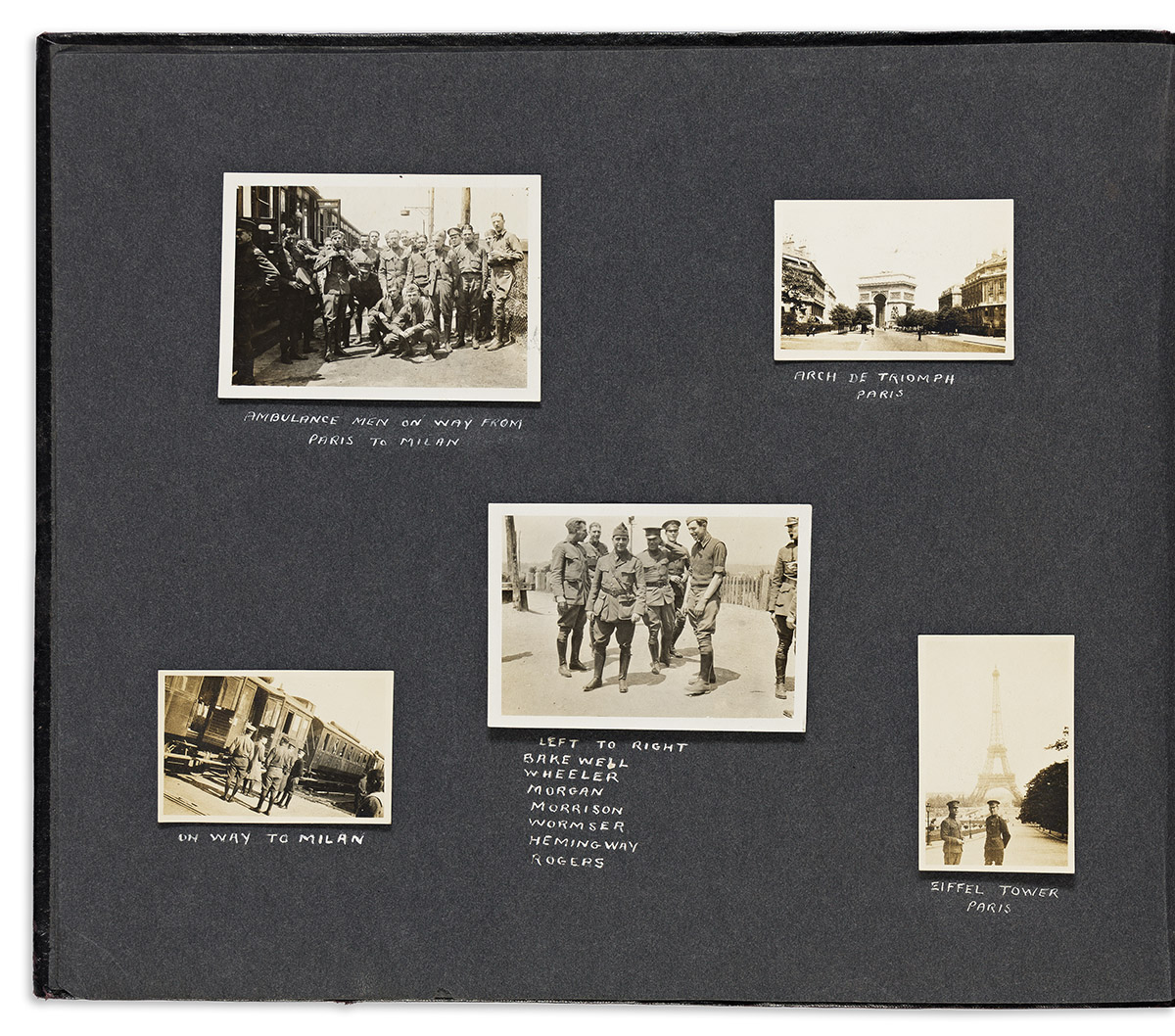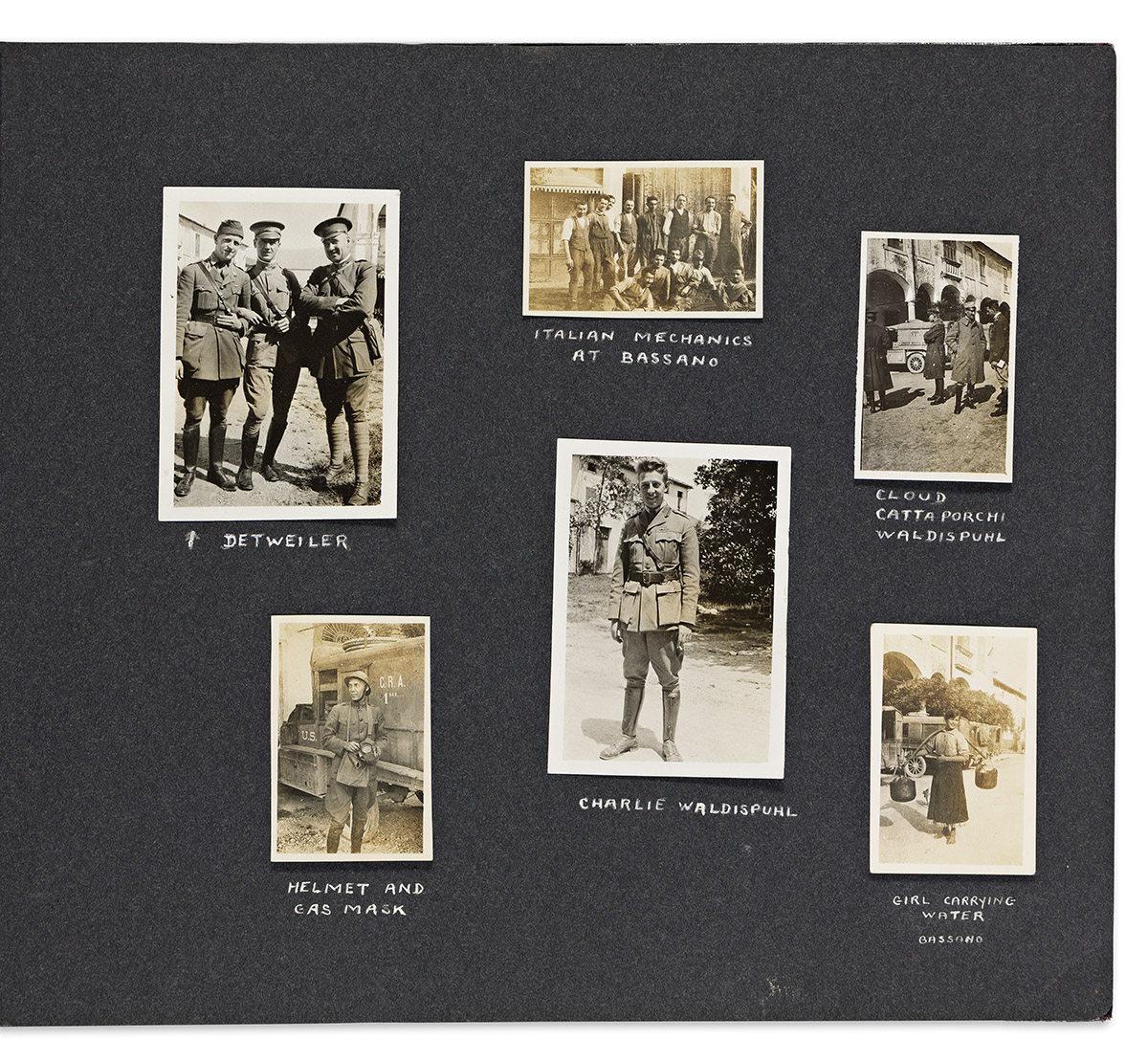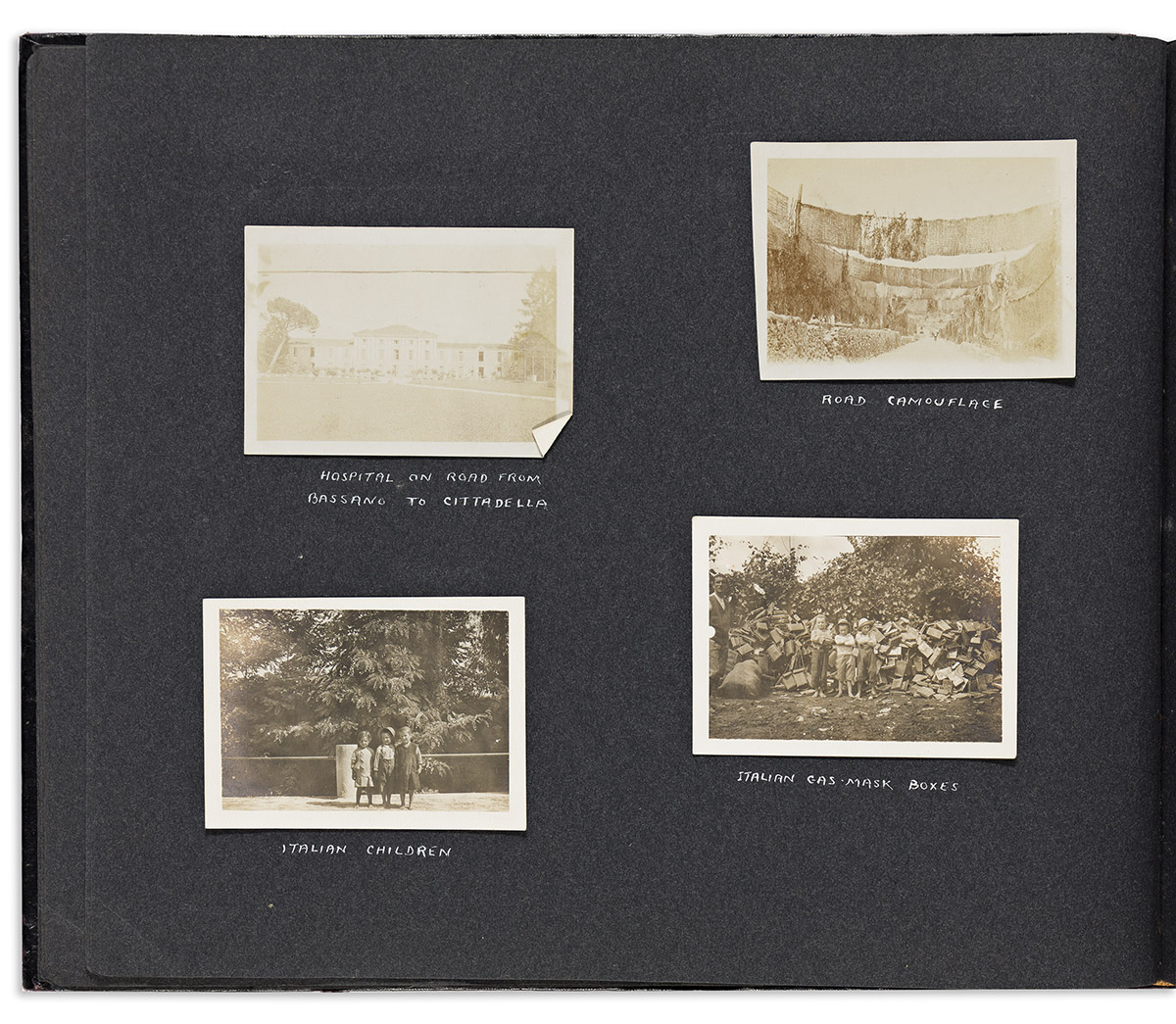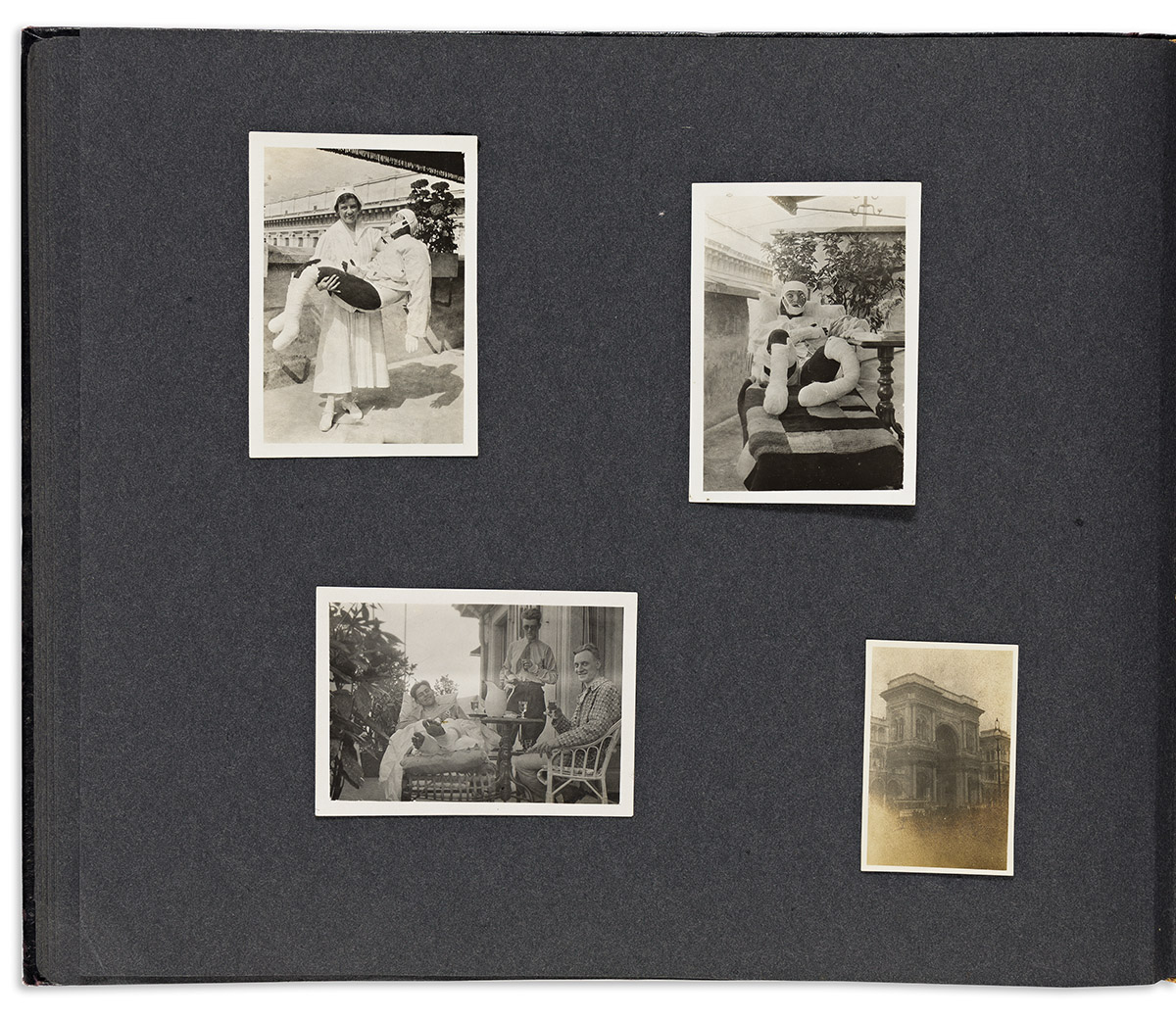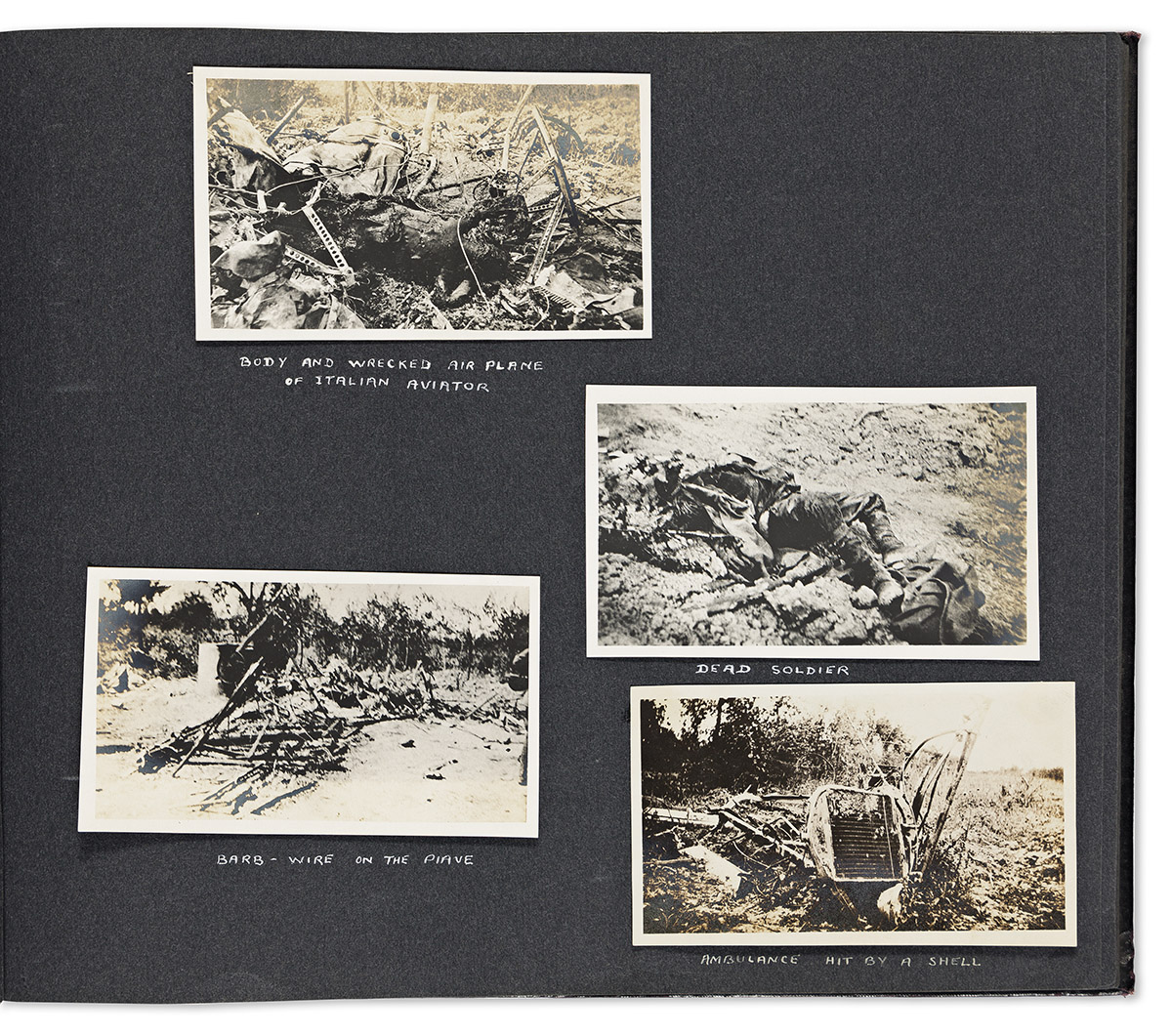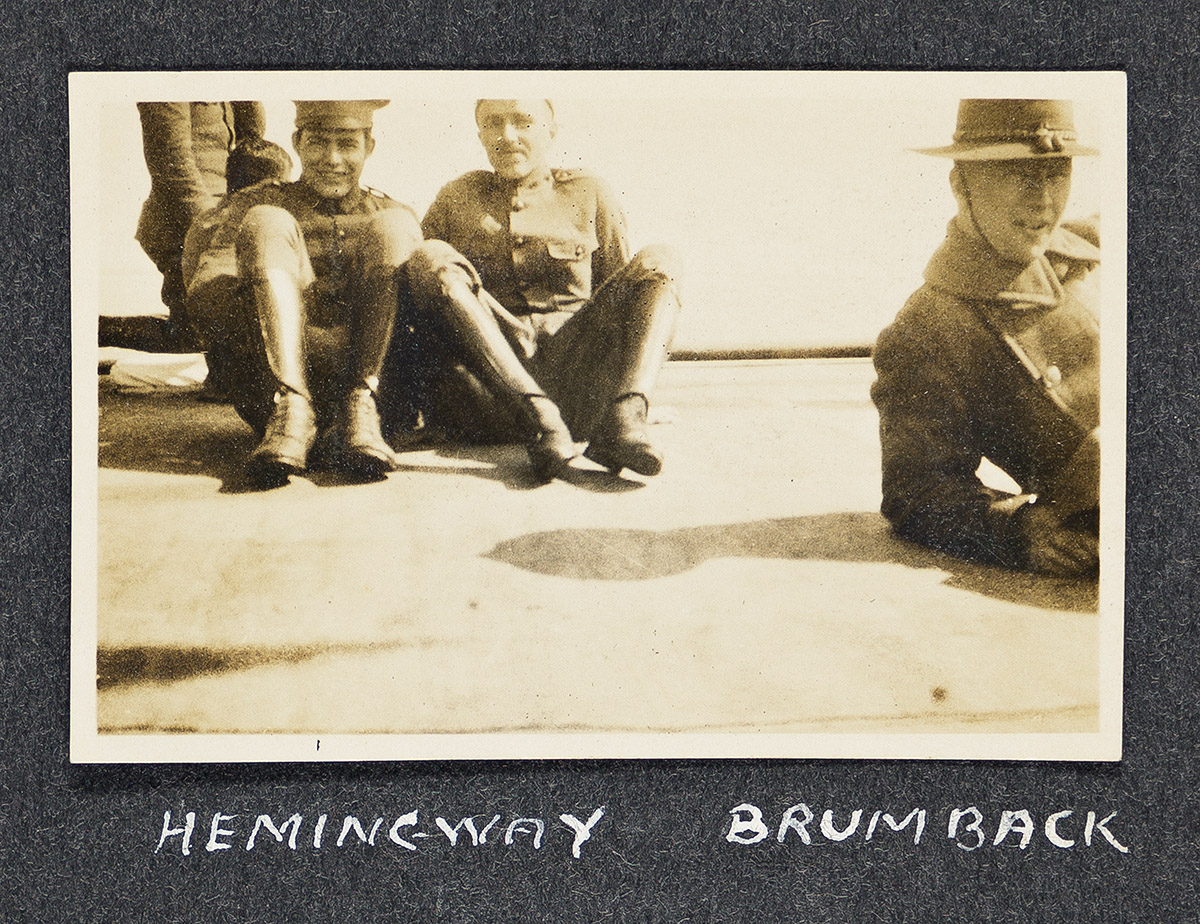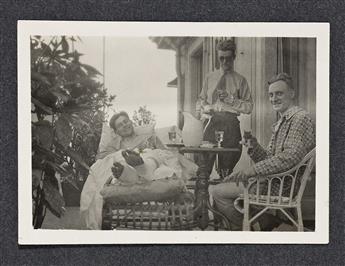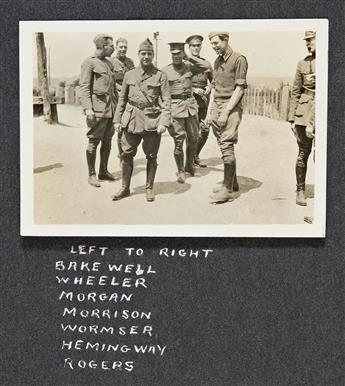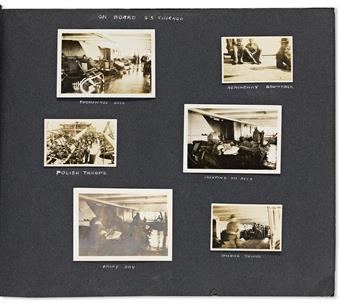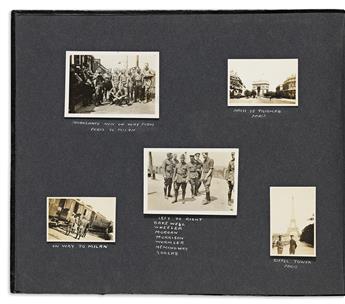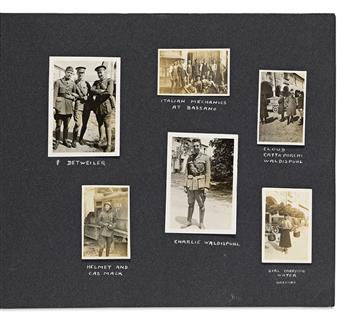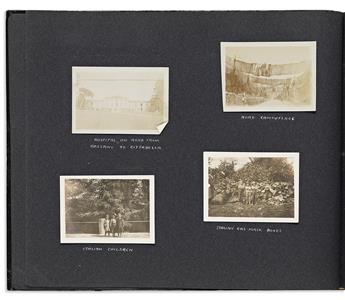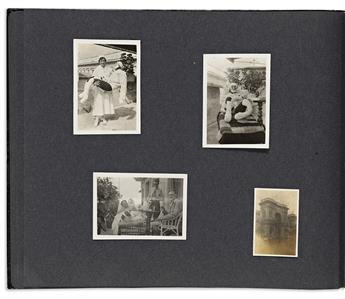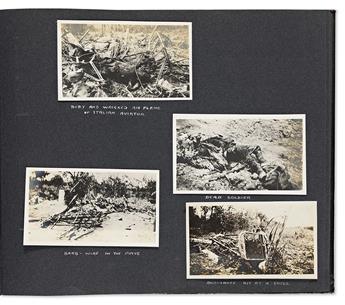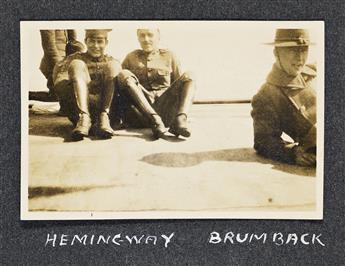Sale 2683 - Lot 232
Price Realized: $ 24,000
Price Realized: $ 30,000
?Final Price Realized includes Buyer’s Premium added to Hammer Price
Estimate: $ 20,000 - $ 30,000
Hemingway, Ernest (1899-1961)
WWI Photo Album Documenting his Volunteer Service in the Ambulance Corps.
Photographs captured between 23 May 1918 and 17 February 1919; subsequently compiled by Percy D. Johnson (1882-1965).
Oblong folio format photo album manufactured by Ward's Stationery of Boston, consisting of 50 leaves of black paper, of which 32 bear 351 mounted black-and-white small format photographs; many captioned on the versos and/or on the album pages in ink; including three images of Hemingway in which he is identified in the caption or on the verso of the print [identified in the inventory below as EH1, EH2 & EH3]; the album itself is bound in a textured black fabric resembling pigskin over padded boards and is in good condition, it measures 12 x 10 in., the photos are all small in format and range in size.
The photos record a number of distinct time periods and are presented chronologically except for the placement of the first image:
1 photo of an unidentified Italian soldier with full equipment;
11 taken on board the SS Chicago, including one of Hemingway [EH1] and Ted Brumback [23 May-3 June];
23 taken in transit from Paris to Milan, including a group photo of ambulance volunteers in which Hemingway [EH2] is identified in the caption [4-5 June];
50 taken in Bassano, Italy, a plethora of images depicting many people including Arditi soldiers, a priest, ambulance volunteers, soldiers, their living quarters and much more;
19 taken around Rosa & Cittadella;
18 taken en route to and at battle sites near Piave, showing machine gun nests, wrecked and war-damaged vehicles, ambulances, and deceased soldiers [possibly aftermath of a munitions factory explosion that occurred on 7 June];
10 photos of soldiers, landscape and "ambulance men" at a town or perhaps encampment identified as Romano;
13 taken at a site called San Felicita showing tent barracks near a funicular;
5 images of the Italian siege howitzer Obice da 280 with troops;
5 photos of the road that ascends Monte Grappa;
5 photos taken at an outpost at Col Moschin showing soldiers of the Arditi in barracks and an operating theater (likely shortly after the Arditi Special Forces took the mountain in their most lauded action of the War on 15-16 June and from which battle they derive their current name);
14 images showing the aftermath of violence on the Piave including roads and battlefields in the area, images of Austrian wounded and prisoners, Italian soldiers in bunkers, and similar subjects;
5 photos of another very large Italian shell-launching weapon identified as a "105 Gun";
9 photos of ambulance volunteers and Italian soldiers at locations identified as "Val de Lebe," "Caston," and "Campo Croce" (including 4 photos of ambulances and their drivers);
16 photos of structures and soldiers at military installments on Monte Grappa including men riding the funicular;
13 photos of troops and volunteers at Galleria on Monte Grappa;
6 photos taken in Austria showing destruction;
6 photos taken in Milan (including two of Johnson);
3 pictures taken at the Milan hospital while Johnson was visiting Hemingway sometime after 14 July, including a photo of a smiling Hemingway [EH3] with bandaged legs accompanied by Coles van B. Seeley and an unidentified man, a photo of a nurse carrying a full-sized dummy of an injured patient, and another of the dummy in a chaise lounge;
the next 80 images record Johnson's sightseeing trip around Europe;
followed by 39 images of his voyage home and his arrival aboard the Dante Alighieri which sailed from Genoa on 26 January 1919 and arrived in New York on 17 February, with a short stop in Gibraltar on the way. Hemingway had preceded Johnson by several weeks, returning on the Guiseppe Verdi, which sailed from Genoa on 4 January and arrived in New York on the 21st of that month.
Of the 351 photographs present, 232 were taken during the travel and service of the ambulance volunteers. The remaining 119 were taken by Johnson of his own subsequent journey, following an itinerary very similar to Hemingway's at roughly the same time.
Johnson has identified 21 members of the Ambulance Service by name. All but one are confirmed members. A full list is available upon request. Many Italian soldiers, officers, civilians and others are also pictured, some are identified by name.
At 18, Ernest Hemingway was writing for the Kansas City Star and itching for adventure. His colleague at the paper, Theodore Brumback, a former volunteer himself, told Hemingway about his experiences serving in the Red Cross Ambulance Service. The two shipped out for overseas service in May of 1918. Hemingway's experiences and those of his many contacts, military and otherwise, shaped him as a young man and as an artist. After sustaining major injuries from an Austrian mortar attack on July 8, 1918, his service was cut short, the war ended, and the young writer's life went along a different set of tracks.
Percy Johnson also volunteered for the Ambulance Service. He crossed the Atlantic on the same vessel. Hemingway and Johnson were assigned to different sections but saw much of the same territory and must have had some sort of personal connection. Johnson visited Hemingway in the hospital after his injuries, and they reportedly were in touch after the war.
Because of Johnson's interest in documenting his experiences in pictures, we have this extraordinary album. Without his diligent adherence to capturing the images and seeing to the subsequent tasks of developing the film, creating the prints, carefully annotating them, mounting and captioning them in this album, all of the information contained in its pages could have been lost.
It may be superfluous to mention the importance of Hemingway's time in Europe during the War. Without it, we would not have A Farewell to Arms. The following is quoted from his introduction to the first illustrated edition published by Scribner's in 1948, as he reflects on writing the book in 1929. "I remember living in the book and making up what happened in it every day. Making the country and the people and the things that happened I was happier than I had ever been. Each day I read the book through from the beginning to the point where I went on writing and each day I stopped when I was still going good and when I knew what would happen next."
"In Italy when I was at the war there, for one thing that I had seen or that had happened to me, I knew many hundreds of things that had happened to other people who had been in the war in all of its phases. My own small experiences gave me a touchstone by which I could tell whether stories were true or false and being wounded was a password." (Quoted from "On Writing in the First Person" from the restored edition of A Moveable Feast, 2009.) Moreover, as James D. Brasch astutely observes in That Other Hemingway: The Master Inventor, "Hemingway believed that fiction was capable of capturing the truth of a situation more accurately than any straight-forward reporting. [...] Truth is not a factual record on which fiction can be based, but truth is a dimension of fiction beyond facts."
Provenance: The album was purchased from Percy D. Johnson's widow, Helen C. Johnson, at a yard sale held nine years after Johnson's death at his family home in New Jersey, over the Fourth of July weekend in 1976. According to the purchaser, who bought the album from Mrs. Johnson and spoke to her about its contents, she reported that Hemingway had kept in touch with Percy and wrote to ask about the photos. At least five photographs have been removed from the album, two from the time of the men's service, three from Johnson's passage home. Only one missing photo is survived by its caption, "Our House at Bassano." The other is in the section that contains four images of ambulances and their drivers. Whether these photos were ever removed and sent along to Hemingway is unknown at the time of cataloguing.
WWI Photo Album Documenting his Volunteer Service in the Ambulance Corps.
Photographs captured between 23 May 1918 and 17 February 1919; subsequently compiled by Percy D. Johnson (1882-1965).
Oblong folio format photo album manufactured by Ward's Stationery of Boston, consisting of 50 leaves of black paper, of which 32 bear 351 mounted black-and-white small format photographs; many captioned on the versos and/or on the album pages in ink; including three images of Hemingway in which he is identified in the caption or on the verso of the print [identified in the inventory below as EH1, EH2 & EH3]; the album itself is bound in a textured black fabric resembling pigskin over padded boards and is in good condition, it measures 12 x 10 in., the photos are all small in format and range in size.
The photos record a number of distinct time periods and are presented chronologically except for the placement of the first image:
1 photo of an unidentified Italian soldier with full equipment;
11 taken on board the SS Chicago, including one of Hemingway [EH1] and Ted Brumback [23 May-3 June];
23 taken in transit from Paris to Milan, including a group photo of ambulance volunteers in which Hemingway [EH2] is identified in the caption [4-5 June];
50 taken in Bassano, Italy, a plethora of images depicting many people including Arditi soldiers, a priest, ambulance volunteers, soldiers, their living quarters and much more;
19 taken around Rosa & Cittadella;
18 taken en route to and at battle sites near Piave, showing machine gun nests, wrecked and war-damaged vehicles, ambulances, and deceased soldiers [possibly aftermath of a munitions factory explosion that occurred on 7 June];
10 photos of soldiers, landscape and "ambulance men" at a town or perhaps encampment identified as Romano;
13 taken at a site called San Felicita showing tent barracks near a funicular;
5 images of the Italian siege howitzer Obice da 280 with troops;
5 photos of the road that ascends Monte Grappa;
5 photos taken at an outpost at Col Moschin showing soldiers of the Arditi in barracks and an operating theater (likely shortly after the Arditi Special Forces took the mountain in their most lauded action of the War on 15-16 June and from which battle they derive their current name);
14 images showing the aftermath of violence on the Piave including roads and battlefields in the area, images of Austrian wounded and prisoners, Italian soldiers in bunkers, and similar subjects;
5 photos of another very large Italian shell-launching weapon identified as a "105 Gun";
9 photos of ambulance volunteers and Italian soldiers at locations identified as "Val de Lebe," "Caston," and "Campo Croce" (including 4 photos of ambulances and their drivers);
16 photos of structures and soldiers at military installments on Monte Grappa including men riding the funicular;
13 photos of troops and volunteers at Galleria on Monte Grappa;
6 photos taken in Austria showing destruction;
6 photos taken in Milan (including two of Johnson);
3 pictures taken at the Milan hospital while Johnson was visiting Hemingway sometime after 14 July, including a photo of a smiling Hemingway [EH3] with bandaged legs accompanied by Coles van B. Seeley and an unidentified man, a photo of a nurse carrying a full-sized dummy of an injured patient, and another of the dummy in a chaise lounge;
the next 80 images record Johnson's sightseeing trip around Europe;
followed by 39 images of his voyage home and his arrival aboard the Dante Alighieri which sailed from Genoa on 26 January 1919 and arrived in New York on 17 February, with a short stop in Gibraltar on the way. Hemingway had preceded Johnson by several weeks, returning on the Guiseppe Verdi, which sailed from Genoa on 4 January and arrived in New York on the 21st of that month.
Of the 351 photographs present, 232 were taken during the travel and service of the ambulance volunteers. The remaining 119 were taken by Johnson of his own subsequent journey, following an itinerary very similar to Hemingway's at roughly the same time.
Johnson has identified 21 members of the Ambulance Service by name. All but one are confirmed members. A full list is available upon request. Many Italian soldiers, officers, civilians and others are also pictured, some are identified by name.
At 18, Ernest Hemingway was writing for the Kansas City Star and itching for adventure. His colleague at the paper, Theodore Brumback, a former volunteer himself, told Hemingway about his experiences serving in the Red Cross Ambulance Service. The two shipped out for overseas service in May of 1918. Hemingway's experiences and those of his many contacts, military and otherwise, shaped him as a young man and as an artist. After sustaining major injuries from an Austrian mortar attack on July 8, 1918, his service was cut short, the war ended, and the young writer's life went along a different set of tracks.
Percy Johnson also volunteered for the Ambulance Service. He crossed the Atlantic on the same vessel. Hemingway and Johnson were assigned to different sections but saw much of the same territory and must have had some sort of personal connection. Johnson visited Hemingway in the hospital after his injuries, and they reportedly were in touch after the war.
Because of Johnson's interest in documenting his experiences in pictures, we have this extraordinary album. Without his diligent adherence to capturing the images and seeing to the subsequent tasks of developing the film, creating the prints, carefully annotating them, mounting and captioning them in this album, all of the information contained in its pages could have been lost.
It may be superfluous to mention the importance of Hemingway's time in Europe during the War. Without it, we would not have A Farewell to Arms. The following is quoted from his introduction to the first illustrated edition published by Scribner's in 1948, as he reflects on writing the book in 1929. "I remember living in the book and making up what happened in it every day. Making the country and the people and the things that happened I was happier than I had ever been. Each day I read the book through from the beginning to the point where I went on writing and each day I stopped when I was still going good and when I knew what would happen next."
"In Italy when I was at the war there, for one thing that I had seen or that had happened to me, I knew many hundreds of things that had happened to other people who had been in the war in all of its phases. My own small experiences gave me a touchstone by which I could tell whether stories were true or false and being wounded was a password." (Quoted from "On Writing in the First Person" from the restored edition of A Moveable Feast, 2009.) Moreover, as James D. Brasch astutely observes in That Other Hemingway: The Master Inventor, "Hemingway believed that fiction was capable of capturing the truth of a situation more accurately than any straight-forward reporting. [...] Truth is not a factual record on which fiction can be based, but truth is a dimension of fiction beyond facts."
Provenance: The album was purchased from Percy D. Johnson's widow, Helen C. Johnson, at a yard sale held nine years after Johnson's death at his family home in New Jersey, over the Fourth of July weekend in 1976. According to the purchaser, who bought the album from Mrs. Johnson and spoke to her about its contents, she reported that Hemingway had kept in touch with Percy and wrote to ask about the photos. At least five photographs have been removed from the album, two from the time of the men's service, three from Johnson's passage home. Only one missing photo is survived by its caption, "Our House at Bassano." The other is in the section that contains four images of ambulances and their drivers. Whether these photos were ever removed and sent along to Hemingway is unknown at the time of cataloguing.
Exhibition Hours
Exhibition Hours
Aliquam vulputate ornare congue. Vestibulum maximus, libero in placerat faucibus, risus nisl molestie massa, ut maximus metus lectus vel lorem.



